Sourdough: The Bread that Loves you Back
How three ingredients and a little time can transform the way your body feels about bread.
I don’t know about you, but I am pretty sure I came out of my mother’s womb loving bread. Seriously—bread and I have always had an understanding. That understanding usually involves lots of butter, a warm slice fresh out of the oven, and good times all around.
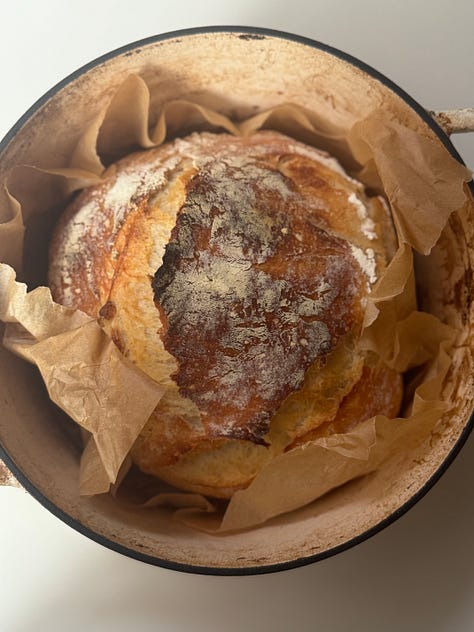

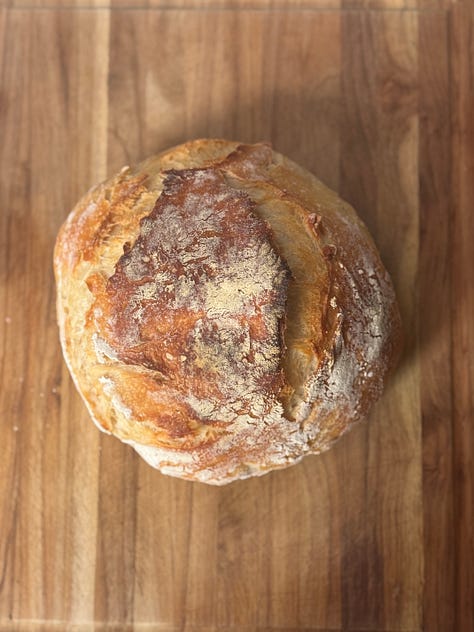
Before pursing my Master’s in Nutrition, I learned a heartbreaking truth: most modern bread isn’t what it used to be. It’s loaded with additives, stripped of nutrients, and often hard to digest. For someone who loves bread as much as I do, this felt like betrayal.
Then came my research into nutrition and so I found sourdough. Real sourdough. The kind fermented with wild yeast, built from tradition, and celebrated in kitchens around the world for centuries. I saw a bread that not only tasted better but was actually good for you—and I knew I had to try it for myself.
That was the beginning of my sourdough story—and I’ve been baking, learning, and loving every loaf since.
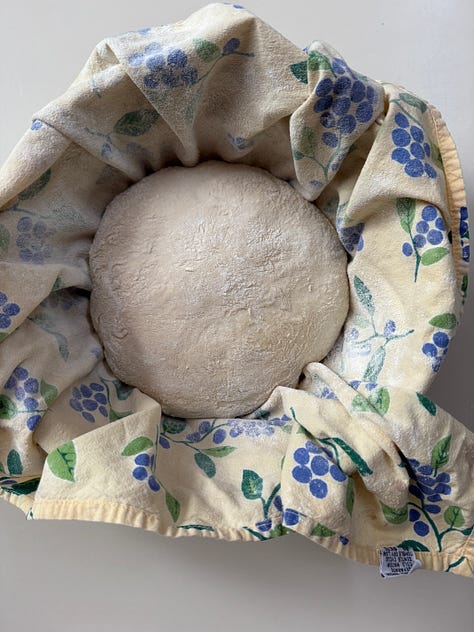
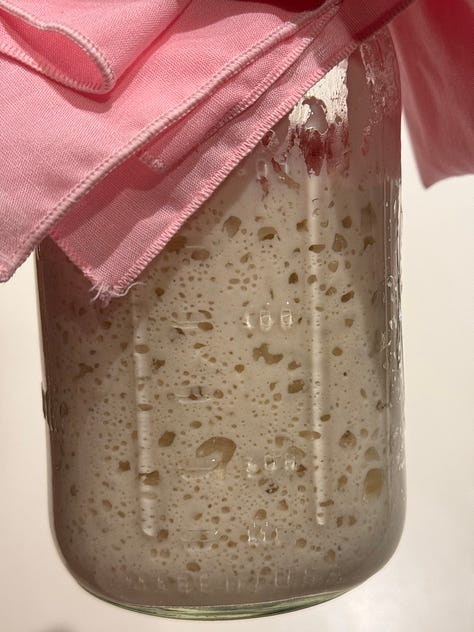
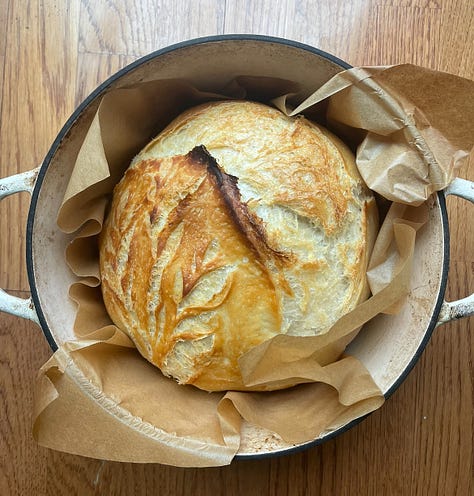
In truth, I debated writing a post on sourdough.
There is already a wealth of knowledge out there—guides, books, experts. But after some thought (and a warm, chewy slice slathered in butter), I realized: I love sourdough. It brings me joy, nourishment, and connection. So why wouldn’t I share it?
Sourdough is a continual journey—its nourishment, its intention, its ability to slow down and root us in something ancient and alive. So, whether you're just sourdough-curious or already neck-deep in a jar of bubbling starter, there's something here for you.
In this Rabbit Hole, you’ll find:
A Deep Dive into the Research of Sourdough
A Simple Starter Recipe to Begin Your Own Journey
Discard Ideas to Make the Most of Your New Starter
A Personal Reflection
Let’s go down The Rabbit Hole.
The Research of Sourdough
1. Is Sourdough Easier to Digest?
It’s a question I’m often asked—and one I continue to explore with both personal experience and a nutritionist’s curiosity.
Sourdough is often praised for its flavor, but its greatest gift might be how it loves your gut. While most live probiotics don’t survive the heat of baking, the fermentation process that happens before baking does some incredible work.
Fermentation
During fermentation, wild yeasts and lactic acid bacteria (LAB) break down complex compounds in flour. This slow, natural process creates:
Postbiotics: These are the beneficial byproducts of fermentation—like enzymes and organic acids. There is increasing evidence that links postbiotics to help regulate inflammation, support your immune system, and contribute to a thriving microbiome.
Prebiotics: Sourdough fermentation boosts prebiotic content—non-digestible fibers that feed the good bacteria already living in your gut.
Certain research also suggests that a diet rich in fermented foods enhances the diversity of gut microbes which, in turn, decreases inflammatory proteins and improves immune response.
Short-chain fatty acids (SCFAs): Fermentation increases the availability of SCFAs like butyrate, which help strengthen the gut lining, reduce inflammation, and support brain function via the gut-brain axis.
***Next week I am going down the rabbit hole of the gut-brain axis! Don’t miss out — subscribe to get notified!
Digestive Sensitivities
Sourdough fermentation also begins breaking down two common digestive troublemakers:
Gluten: The slow rise of sourdough allows enzymes and acids to partially degrade gluten, making it easier on the digestive system for many who are sensitive (click here and here to learn more).
IMPORTANT NOTE: sourdough is not suitable for those with celiac disease as the fermentation doesn’t degrade gluten completely.
Phytic acid: Often called an "anti-nutrient," phytic acid binds to minerals like iron and zinc and reduces absorption. Fermentation breaks this down, allowing your body to absorb more nutrients from the bread itself.
FODMAPs: For those with Irritable Bowel Syndrome (IBS) or sensitive digestion, sourdough fermentation may reduce the FODMAP content of wheat, making it potentially more tolerable. However…
A study on 26 individuals with IBS found that even sourdough bread fermented for over 12 hours—containing lower levels of both ATIs and FODMAPs—was not better tolerated than regular bread. This reminds us that food sensitivity is highly individual, and sourdough is not a guaranteed solution for everyone.
Whole Ingredients
In a world of ultra-processed everything, there's something restorative about going back to basics. Historically, our ancestors ate foods that were closer to the earth—unrefined, unfortified, and full of life. Their bread was made from grains they grew, milled, and fermented themselves. It wasn’t packed with gums, dough conditioners, preservatives, or added sugars—it was simply bread.
At its core, sourdough is made from just three ingredients:
Flour - Water - Salt
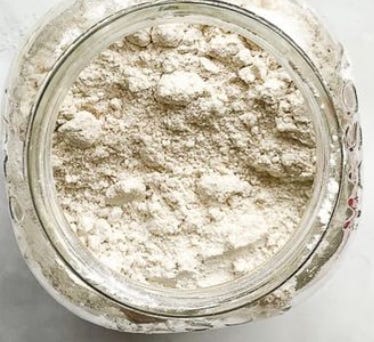


That’s it.
No synthetic additives. No refined sugars. No seed oils. Just real food, made slowly.
And that simplicity matters—because your body recognizes whole, minimally processed ingredients. They're easier to digest, studies show, more nourishing, and less likely to trigger inflammation or blood sugar crashes.
Sourdough takes what is ancient and makes it accessible again. And in doing so, it reminds us that sometimes the most powerful thing we can do for our health is to return to what’s real.
A Note on the Research
So—is sourdough easier to digest? For many, yes. Personally, I’ve found it to be far more nourishing and far less bloating than fast-risen, store-bought bread. But it’s also important to acknowledge the nuance.
According to a recent peer-reviewed conclusion:
“The benefits of sourdough-fermented bread on glycemic response, satiety, or gastrointestinal distress were reported in some studies but not in others... the high diversity of bacterial strains, fermentation conditions, or bread recipes used makes it difficult to identify the main determinants of the effects.”
In short: while sourdough shows great promise, more standardized research is needed before we can make blanket health claims. Still, many studies agree that sourdough fermentation enhances mineral availability, improves texture and flavor, and may be a more nutrient-dense and gut-friendly option overall.
2. Blood Sugar-Friendly
Sourdough has a lower glycemic index than conventional bread.
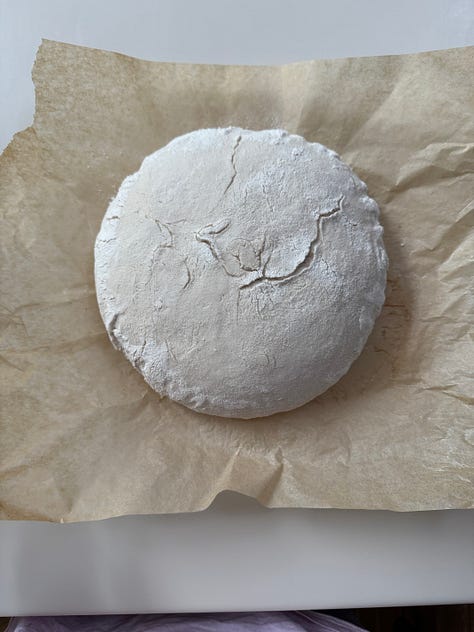
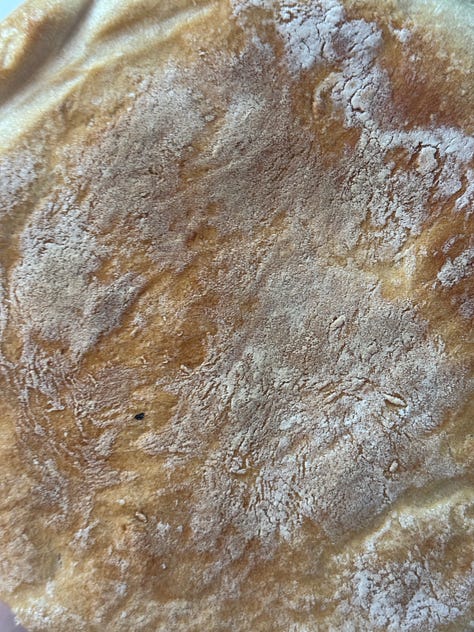
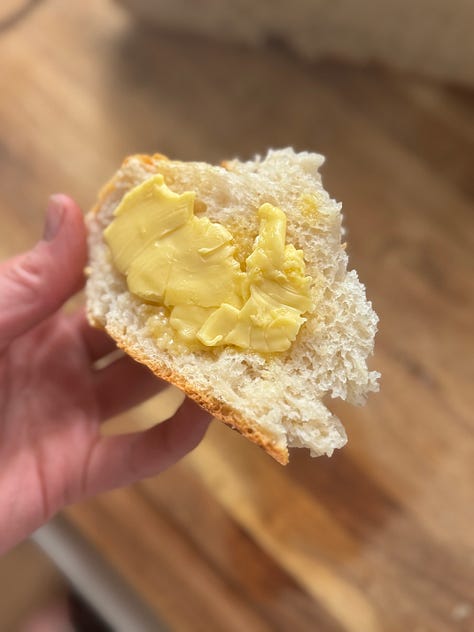
A low-glycemic index (GI) diet can be especially beneficial for several groups of people, particularly those who are concerned with energy regulation, mood stability, and hormone balance. Here’s a breakdown of who might want to prioritize it and why:
Women with Hormonal Imbalances
Balanced blood sugar is foundational for hormone regulation—especially for women. The resistant starch and gut-healing benefits of sourdough support estrogen metabolism, reduce inflammation, and promote long-term hormonal harmony.
PCOS: According to the CDC, Women with polycystic ovary syndrome often have insulin resistance; low-GI foods help reduce insulin spikes, which supports better hormone regulation.
PMS or PMDD: According to new research from Harvard T.H. Chan School of Public Health, menstrual cycle phases can influence individuals’ blood glucose levels. Blood sugar fluctuations can exacerbate mood swings, fatigue, and cravings. A low-GI diet helps stabilize these shifts.
People with Insulin Resistance or Type 2 Diabetes
Literature suggests low-GI foods prevent sharp rises in blood sugar and insulin levels, helping to maintain healthy glucose control and avoid crashes. According to a 2019 meta analysis, low-GI diets may be useful for glycemic control and may reduce body weight in people with pre-diabetes or diabetes (type 1 or 2).
Individuals with Mood Swings, Anxiety, or Depression
A 2020 research review has shown mixing results suggesting that fluctuating blood sugar levels can worsen irritability, anxiety, and fatigue. In theory, keeping blood sugar steady with low-GI foods supports more consistent mood and mental clarity.
Athletes or Active Women (Especially in Luteal Phase)
Research suggests that during the luteal phase (post-ovulation), women often have increased insulin sensitivity needs. Low-GI carbs paired with protein and fat help manage cravings and sustain energy.
Those Trying to Lose Weight Sustainably
Low-GI foods help control appetite by supporting satiety hormones (like leptin) and minimizing crashes that lead to overeating, according to studies.
3. More Nutrient-Dense + Naturally Preserved
Fermentation increases the bioavailability of key minerals like zinc, magnesium, and B vitamins.
Why is Zinc important?
Hormone health. Research suggests zinc is crucial in balancing hormones like progesterone, testosterone, and thyroid function. Keeping your mind happy and your body healthy
Research suggests, zinc decreases oxidative stress and reduces levels of certain inflammatory proteins in your body
Boosts immune health and repairs tissue, including the reproductive tract
Signs of low zinc: PMS, irregular cycles, hair loss, low libido, poor wound healing, mood dips
Best food sources: Oysters (highest source!), beef, pumpkin seeds, chickpeas, cashews
Why is Magnesium Important?
Has been studied in calming the nervous system
Supports sleep, muscle relaxation, and eases muscle contraction (including menstrual cramps)
According to a review, magnesium aids in blood sugar balance, which stabilizes mood and hunger, also helping with type-2 diabetes.
Signs of low magnesium: Cramps, anxiety, chocolate cravings, insomnia, twitching muscles
Best food sources: Dark leafy greens, almonds, pumpkin seeds, dark chocolate, avocado, whole grains
Why are B Vitamins (especially B6, B12, and Folate) Important?
Studies show B6 helps with premenstrual syndrome by way of estrogen elimination and supports healthy progesterone levels
B12 + Folate support methylation, DNA repair, and red blood cell production, suggest research.
They help modulate stress response and neurotransmitter production (like serotonin). Article here.
Signs of deficiency: Fatigue, brain fog, hormonal acne, PMS, tingling extremities, pale skin
Best food sources:
B6 — salmon, bananas, sunflower seeds, poultry
B12 — animal proteins (meat, fish, dairy, eggs)
Folate — dark leafy greens, legumes, liver, asparagus
How to Start Your Own Sourdough—Without being Overwhelmed
Starting sourdough can feel intimidating—especially with all the jargon, timelines, and perfectly scored loaves floating around on the internet. But here’s the truth: it doesn’t have to take over your life.
You don’t need special equipment. You don’t need to bake every day. You don’t need to get it perfect.
All you need is a little curiosity, a jar, some flour, water, and a willingness to be patient with the process (and yourself). Let’s walk through it together, step by step:
Step 1: Get or Make a Starter
What is a starter?
A sourdough starter is a living culture of wild yeast and lactic acid bacteria. It’s what makes sourdough bread rise and gives it that signature tang and depth of flavor. Unlike commercial yeast, this one lives with you—it evolves with your kitchen and becomes uniquely yours.
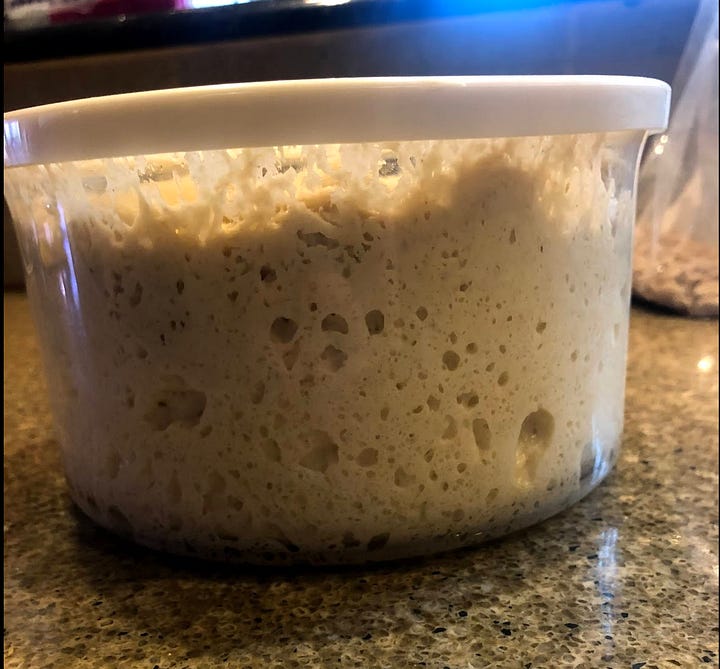
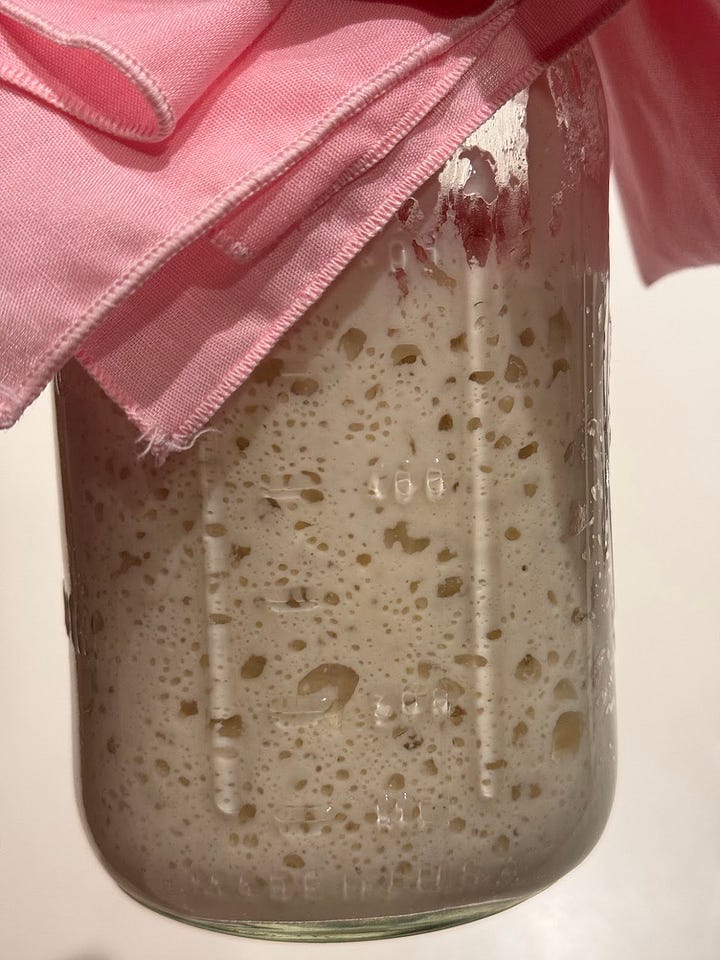
Two ways to get started:
🌱 Option 1: Make Your Own
All you need is:
Unbleached all-purpose or whole wheat flour
Filtered or dechlorinated water
A glass jar or bowl
A spoon or spatula
A breathable cloth or coffee filter + rubber band
You’ll mix equal parts (120g) flour and water (or about ½ cup of each), stir, cover, and let it sit at room temp. Feed it once a day (discarding half, and adding fresh flour + water… another 120g of each) for about 5–7 days. Bubbles, tang, and rise are all signs of a happy culture!
🌾 Option 2: Adopt a Starter
Ask a friend, a local baker, or purchase one from a trusted online source. It’s a shortcut that gives you a head start with an established culture.
*I adopted my starter from a friend’s sister-in-law back in 2020! Bubs (my starter) has been with me for 5 years now :’)
Step 2: Keep It Alive—Easily!
Sourdough sounds high-maintenance, but it’s surprisingly low-effort once you find your rhythm. Think of your starter like a low-maintenance pet or a chill houseplant—it needs food, but it doesn’t ask for perfection.
If you’re baking often: Leave it on the counter, discard half and feed it once a day. Using the discarded half in a delicious recipe.
If you’re baking occasionally: Store it in the fridge and feed it once a week. That’s it. When you’re ready to bake, just take it out, and feed it once or twice to bring it back to life. use the discard in a yummy recipe, when you have all you need, put it back in the fridge until your ready for more sourdough. This is what I do!!
Feeding: The ratio is 1:1:1 of starter, water, and flour by weight—or roughly ¼ cup of each if you’re eyeballing). I do 120g (give or take) of each. Notice in my images below I added 122g of water and 121g of flour. I think it’s important to note that you do not have to be perfect here, but look for the right consistency that isn’t too wet or bone dry.
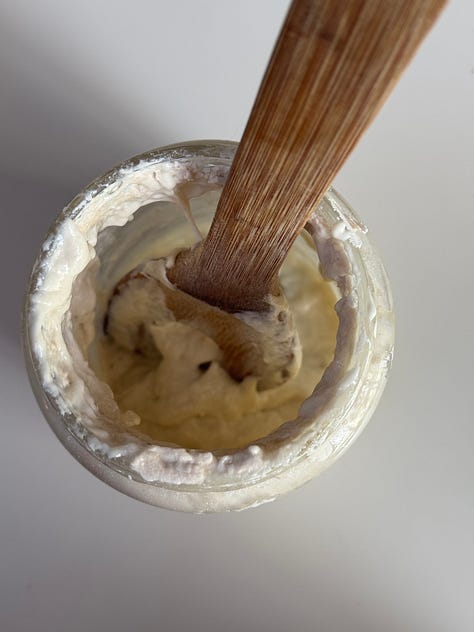
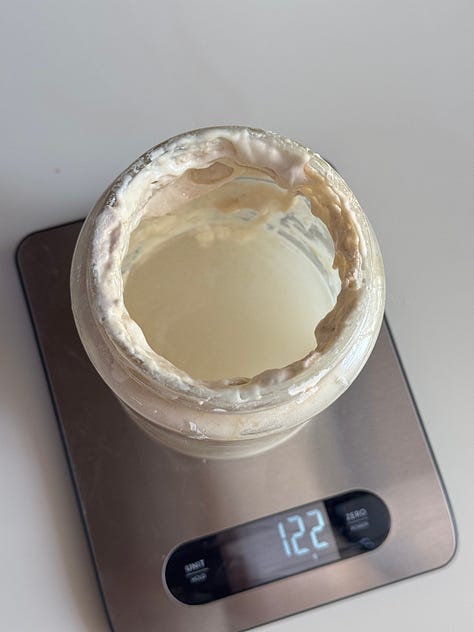
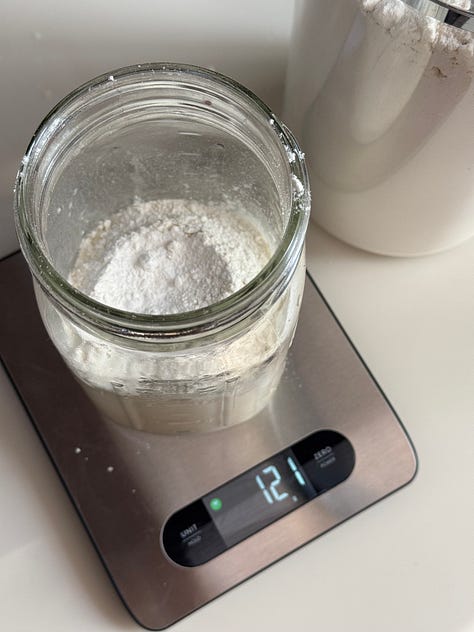
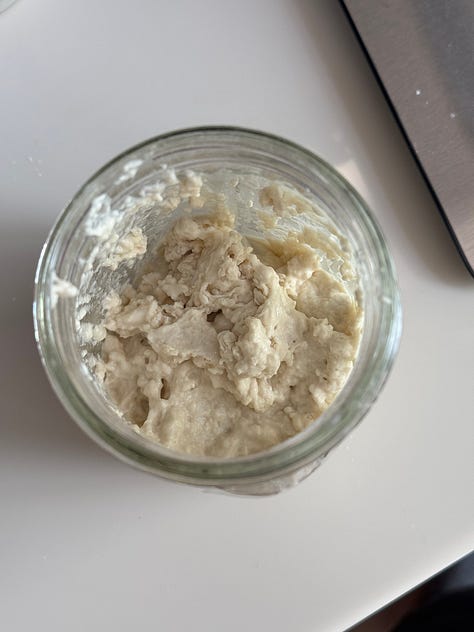
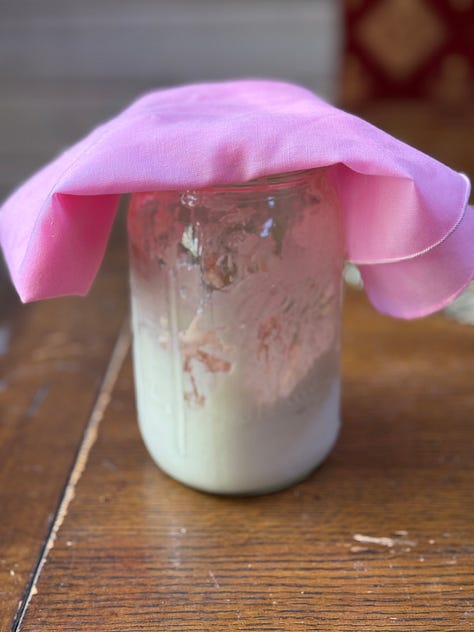

Pro Tip: Always leave room in your jar—your starter will grow.
Ask me how I know… in one of my first feedings, my starter bubbled over and made a complete mess. Sticky dough everywhere. Lesson learned: use a jar with room to triple in size!
Another Pro Tip: add the water first mix until milky, then flour. It’s easier to mix that way.
Step 3: Bake Something Simple & Delicious
You don’t need to dive headfirst into artisan loaves with lamination and scoring. Start with something approachable and nourishing:
Focaccia
Crackers from discard
Cheesy crackers
Dumplings
Pancakes or waffles
Pizza dough
Cinnamon rolls (yes, really)
Cookies, Cakes, Brownies and the list continues!
Click the link below for full recipes!
Start simple, and let yourself be surprised by how doable—and deeply satisfying—it is.
What Sourdough Has Taught Me
Sourdough has shown me that fermentation is incredibly forgiving. I’ve forgotten my starter in the fridge for six months, only to feed it twice and be rewarded with a beautiful loaf. I’ve had flat loaves, overly tangy disasters, and dough that stuck to everything—but the starter? She always survives… And that’s what makes sourdough so magical. It doesn’t punish you for trying. It welcomes you back every time with open arms (and a bubbly jar).
If you’re new to fermentation, I can’t recommend sourdough enough. It’s versatile, low-maintenance, and endlessly rewarding.
I haven’t even scratched the surface of flavor experiments yet—but I’m so excited to bring you along as I try new things: jalapeño cheddar, cinnamon raisin, seeded loaves, maybe even a chocolate rye. I will be documenting them to my Substack so please Subscribe to see more content (and rabbit holes) like this one!
Bread should be fun. Bread should be shared. Bread should be eaten. And that’s exactly what I plan to do.
Sourdough isn’t just a trend—it’s a return to real food. And after everything we’ve explored in this rabbit hole—from the low glycemic index, digestion, hormonal support, to nutrient density—it’s easy to see why. As someone with a Master’s in Nutrition, I truly believe sourdough is one of the most accessible, sustainable, and health-supportive ways to bring healing back to our plates.
If this post helped you, send it to one friend who needs to hear this. Let’s nourish each other.
As always, thank you so much for being here and supporting this little corner of nourishment and curiosity.
—Victoria Louise





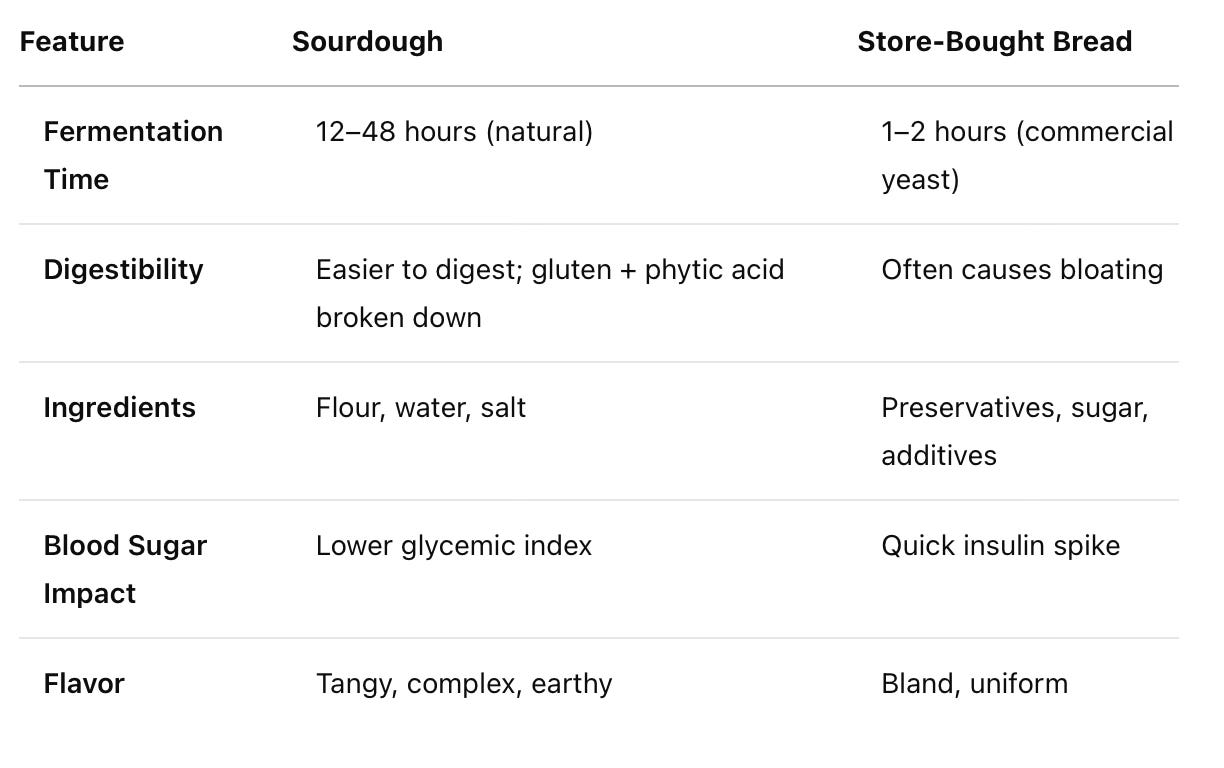
This is such a refreshing post! Thank you for your research 🫶🏽
wowwww gotta try this